|
Thurs., July 19
10:30 a.m.
Research Techniques Seminar - WH-10NW, West Wing
Speaker: T. Pierzchala, Université Catholique de Louvain
Title: GASTOF: A Fast Time-of-Flight Counter for LHC Experiments
1:00 p.m.
ILC ALCPG Physics and Detector R&D Seminar - WH-10NW, West Wing
Speaker: T. Rizzo, Stanford Linear Accelerator Center
Title: LHC-1 = ILC Project Update (take two)
2:30 p.m.
Theoretical Physics Seminar - Curia II
Speaker: J.-W. Qiu, Iowa State University
Title: QCD Factorization for Heavy Quarkonium Production at Collider Energies
3:30 p.m.
DIRECTOR'S COFFEE BREAK - 2nd Flr X-Over
4:00 p.m.
Special Joint Experimental-Theoretical Physics Seminar - One West (NOTE DATE)
Speaker: N. Saoulidou, Fermilab
Title: Updated Results on nu_mu Disappearance from MINOS
THERE WILL BE NO ACCELERATOR PHYSICS AND TECHNOLOGY SEMINAR TODAY
Fri., July 20
11:45 a.m.
Special Brown Bag Lunch Seminar - Curia II
Speaker: C.-M. Chen, Soochow University
Title: Physics Demonstration Using Everyday Objects
2:00 p.m.
Gallery Lecture Series - One West
Speaker: L. Fisher (Artist)
Title: In Search of Meaning
3:30 p.m.
DIRECTOR'S COFFEE BREAK - 2nd Flr X-Over
4:00 p.m.
Joint Experimental-Theoretical Physics Seminar - One West
Speaker: C. Schwanenberger, University of Manchester
Title: Top Quark Physics at D0 as a Probe for New Physics
Click here for NALCAL,
a weekly calendar with links to additional information. |
Thursday, July 19
- Santa Fe black bean
- Sloppy joe
- Chicken cordon blue
- Sauteed liver & onions
- Baked ham & swiss on a ciabatta roll
- Assorted sliced pizza
- Crispy fried chicken ranch salad
*Carb Restricted Alternative
Wilson Hall Cafe Menu |
|
Thursday, July 19
Dinner
- Grilled portobello and red pepper salad
- Scampi
- Vegetable of the season
- Chocolate strawberry shortcake
Wednesday, July 25
Lunch
- Salad of ham, gruyere &
cabbage in roquefort dressing
- Chocolate mousse w/almonds & cookies
Chez Leon Menu
Call x4598 to make your reservation. |
|
|
Changing water levels due to nature, water management
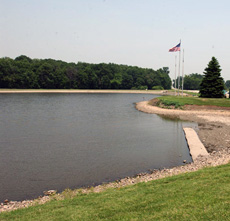
Swan Lake
Lack of rainfall combined with practices to manage low levels of tritium in surface water on the Fermilab site have raised questions about water levels in Fermilab ponds and creeks.
Weeds are plentiful in Lake Law and the AE Sea on the laboratory's east side, where low rainfall amounts and unseasonably hot temperatures have contributed to rapid evaporation. Low rainfall totals are also responsible for dry areas of Indian Creek, in the southwest part of the site, which would normally receive surface run-off from Fermilab's flat lands when it rains. "During an average year, we have the same amount of evaporation as we get rainfall," said ecologist Rod Walton. "This year rainfall is a little below average."
But Walton also said that there is little to be concerned about in terms of the wetlands or the water-dependent ecosystem. "From a long-term perspective, the ecosystem is able to respond to a variety of weather conditions year to year," he said.
Swan Lake's lower than normal water levels have also produced weeds, but have less to do with rain. Some surface water at Fermilab, including Swan Lake, contains low but detectable levels of tritium. Although the tritium levels are far below state and federal standards and are not harmful, Fermilab has committed to ensure that water leaving the site contains the lowest possible levels of tritium -- if possible below detectable levels.
In part, Swan Lake's lower water levels are due to movement of water around the site in periods of low rainfall for fire protection water supply and other water make up needs. Additionally, as part of the laboratory's tritium management process, Swan Lake levels are lower than normal said Randy Ortgiesen, head of Facilities Engineering Services Section. He said FESS has plans to repair the south bank of Swan Lake and raise the water level, which will help prevent weeds from growing, improve aesthetics and help with the site's water management efforts.
During heavy rains, the water elevation in Swan Lake rises enough to allow the resident fish to swim into the "back ditch" - an area near the Lederman Science Center that is used for overflow. When the water evaporates and is moved around the site from Swan Lake, the water levels drop, leaving the fish behind. Ortgiesen said FESS is planning temporary measures to prevent the fish from entering the ditch until a higher water level is able to be restored.
-- Rhianna Wisniewski
|
ArchaeoGrid: a window to the past
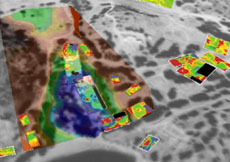
A fusion of aerial satellite data with geophysical maps in Crete, Greece.
Image courtesy of ArchaeoGrid
The life of an archaeologist never was very much like the life of Indiana Jones, and, as the field progresses, it becomes less so.
Research has grown more quantitative. Statistical resources such as large data sets, complex models, and abundant computing power are becoming as important to the archaeologist's toolbox as a notebook, dusting brush, and possibly even bullwhip.
"Starting in the 1960's the field of archaeology saw a change," says Pier Giovanni Pelfer, from the University of Florence, Italy. "Using new techniques and tools, such as carbon-14 dating, researchers were able to ask new questions."
Technology, Pelfer is careful to note, is no substitute for old-fashioned fieldwork. Instead, it is a support, and one that enables new routes of inquiry.
Read More
- Danielle Venton, iSGTW
|
From Nature
July 18, 2007
Editorial: A unifying force
The questions to be explored at the Large Hadron Collider offer a chance to rekindle public interest in the fundamental principles of the Universe in which we live.
The Large Hadron Collider (LHC) that is nearing completion outside Geneva, Switzerland, is a testament to two of the greatest human qualities: a fascination with the workings of the Universe and an ability to cooperate to achieve shared goals. After the machine - now the centrepiece of Europe's particle-physics laboratory, CERN - goes into operation next year, it should allow experimentalists for the first time in decades to blaze paths into areas on which settled theory stands silent (see page 269).
The physicists exploring this new world will do so as a unified global community. Although CERN is broadly a European achievement, in which the continent can take great pride, the LHC and its attendant detectors have received contributions in cash or kind from more or less every country with the capability to participate in this sort of frontier science. The LHC therefore sets a new high-water mark in disinterested global cooperation.
Read more
|
|
|
If top lost its bottom, would it still have charm?
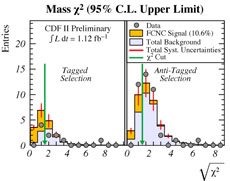
Data points together with background expectation (light blue) as a function of the "χ˛", a variable which denotes how likely events are to contain one top quark decaying normally to a b quark, along with one top quark decaying to a charm (or up) quark. Shown in orange is the maximum allowed fraction of these exotic decays compatible with the CDF data.
Nature seems to follow a strange rule. Although quarks can transform to become quarks of a different charge, nature does not seem to allow quarks to change to quarks with the same charge but different flavor. These so-called "flavor changing neutral currents", or FCNCs for short, are expected to be highly suppressed. According to the Standard Model, a top quark (charge = q = +2/3) can change both its charge and its flavor by decaying to a b quark (q = -1/3). This is expected to happen more than 99% of the time. On the other hand, the top quark is expected to decay without changing charge to a charm or up quark (both q = +2/3) at most 1 in a trillion times. Theorists, however, in their pursuit of a grand unified theory, have invented new models in which the top quark decays less often to a b quark, and more often to a charm or up quark. Any observation of these FCNC decays at the Tevatron would indicate new physics beyond our current Standard Model.
A group of CDF collaborators has set out to search for these FCNC decays in events where a top and anti-top quark are produced together, and one of the top quarks decays as expected to a b quark along with a charged W boson, while the other one decays to a c (or u) quark along with a neutral Z boson. Unfortunately, there is another more mundane Standard Model process that produces this same signature. To distinguish the signal from this background, the group developed a technique to determine the likelihood for the measured particles to reconstruct their masses to those of the top and antitop quark.
The team finds that the number of observed events is consistent with the Standard Model expectation, and that if top quarks decays to a Z and a c (or u) quark, it must happen less than 10.6% of the time. This is currently the world's tightest limit on this decay. CDF is now adding the latest data and refining their analysis technique to probe even further into the world of FCNC decays.
Learn more
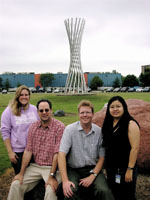 |
Shown: Jennifer Gimmell (Rochester), Charles Plager (UCLA), Ulrich Husemann (Yale), Ingyin Zaw (Harvard). |
|
What was the tent for?
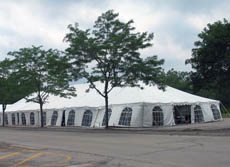
A tent that popped up in the parking lot of Wilson Hall this week had people wondering about its purpose. The tent housed food and beverage service for the 250 attendees of the Summer 07 ESCC/Internet2 Joint Techs Workshop. The workshop held from Sunday, July 15, through today, July 19, focused on hybrid networking, campus networking, security and measurement/performance.
|
|
Salary Review Process Information
General information for all employees on updates to the salary review process is now available online. Please review this presentation. If you have any questions on the information provided or any topic related to the upcoming salary review, please attend one of the town-hall meetings scheduled for 1:30 p.m. on July 25, 26, and 31 in Wilson Hall, One West.
International Folk Dance Thursday
International Folk Dancing will have live accordion music by Don Weeda this Thursday starting at 7:30 p.m. in Ramsey Auditorium. Newcomers are always welcome, and you don't need to come with a partner. Info at 630-584-0825 or 630-840-8194 or email.
Professional Development classes
New classes are always being added to the professional development schedule. For the most up-to-date course offerings, visit the training web site.
Labwide party on August 3
To celebrate our international community and its achievements, the Fermi Research Alliance will host a labwide party in the Wilson Hall atrium on Friday, August 3, from 3:30 to 6:30 p.m. The theme of the party is "World-class people, world-class research." The party will feature international snacks, beverages, music and door prizes. All Fermilab employees, users, contractors and DOE employees are invited.
|
|